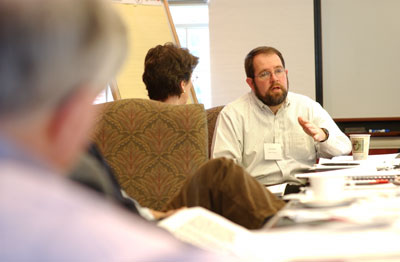
March 23-25, 2003
Participants
John Agresto, Phillip Mikesell and John Ottenhoff represented the Center of Inquiry
Seven of the scholars were selected for their expertise on curriculum:
James Carey, St. John's College
Peg Downes, University of North Carolina-Asheville
Ron Herzman, The State University of New York at Geneseo
Steve Klug, The College of New Jersey
Walter Nicgorski, University of Notre Dame
Ronald A. Sharp, Kenyon College
Bradford Wilson, National Association of Scholars
Institutions
For this study, we wanted a diversity of institutional types and selected a large private university, a large public university, two liberal arts colleges and an experimental liberal arts program, the New College at the University of Alabama:
Joseph Losco, Ball State University
Paul Ranieri, Ball State University
Scott Moore, Baylor University
Donald Schmeltekopf, Baylor University
Terry Boychuk, Macalester College
Andrew Latham, Macalester College
George Sims, Muskingum College
James Hall, New College, University of Alabama
Ann Webb, New College, University of Alabama
--------------------------------------------------------------------------------
As a pilot project for supporting institutional change, John Agresto, Senior Research Fellow, and Phillip Mikesell, Visiting Research Fellow and Professor of Political Science at Wabash College, brought together educators engaged in changing curricula with scholars who have written about the benefits and values of liberal arts education. Rarely do these two groups come together and reflect on what is, after all, their common work. We brought sixteen scholars from fourteen institutions together for a conference (March 23-25), Liberal Arts and Curricular Change. We then selected institutions and invited them to send two individuals who were leading the institution’s efforts to change its curriculum.
The conference focused on two broad questions:
How do we understand both the nature and the value of the liberal arts in contemporary higher education?
With that understanding, how do we organize and implement our educational programs?
The conference opened with a consideration of the liberal arts. What, we asked, was the purpose of a liberal arts education? The discussion of the question was lively. Two foci emerged: one emphasized the intellectual-critical aspect of the liberal arts; the other spoke to the liberal arts as work with a substantive body of valuable knowledge. A good deal of attention was given to the question whether liberal arts work led to stronger moral character. The participants seemed to agree that the study of the liberal arts did not necessarily strengthen moral character. At the same time several participants argued that liberal arts study, by emphasizing self-reflection, critical thinking and empathy, seemed to point toward desirable moral qualities.
The second session, on Monday morning, began with more discussion of the purposes of the liberal arts. After about 45 minutes, we turned to discuss the role of curriculum in realizing liberal arts goals.
The third session continued discussion of the relationship between goals and the organization of courses. While this discussion was not highly focused, the primary point of attention (and contention) was the core approach versus curricula with more options. No one in the group supported a Brown- or Grinnell-like curriculum of no requirements.
In the fourth session we examined actual curricular revision plans. We heard from Macalester, Muskingum, and New College. Each presented a distinctive set of issues surrounding curricular change, but all three highlighted the difficult organizational-political issues of change rather than the questions of curricular goals and means.
In the final session we heard reports from Ball State and Baylor. In contrast to the earlier reports, these two focused exactly on the question of goals and means. Baylor has instituted (and is expanding) an elective great books core. It has a well-developed and articulated purpose and rationale based in Baylor’s Baptist tradition. Ball State, on the other hand, is considering a new set of requirements that will lead students to a new set of university educational goals. Reaction to these two reports was lively and focused squarely on the issue of the goals of liberal arts education and on the means of achieving those goals. As in the opening sessions (but now more grounded in real cases), participants divided between those who emphasized a tighter set of core requirements and those who saw liberal arts goals better realized through existing disciplines and somewhat less tightly focused curricular structure.
Contrary to our initial expectations, no "handbook" for curricular reform can come from these sessions unless it is something we put together with the conference simply as background. Nevertheless, two serious ‘outcomes’ do seem to have occurred. At least one of the colleges mentioned that what they needed was a faculty retreat to reacquaint their faculty with the goals and meaning of liberal education. They may use something similar to the book of readings we assembled as the basis of their discussions. Second, at least two institutions (Baylor and Ball State) were actively inviting different participants to come to their respective campuses to continue this discussion with their faculties and to work with their administrations.
Perhaps the most significant outcome was our recognition that institutions are seeking ways to improve the education of their students through changes in curriculum and ways to assess the outcomes of those changes. We have the opportunity to facilitate the process of such change at those institutions, by helping them to identify and implement changes that improve liberal arts education and by developing effective assessment tools. Working with such institutions enables us to test our theories of liberal arts education and to promote liberal arts education.